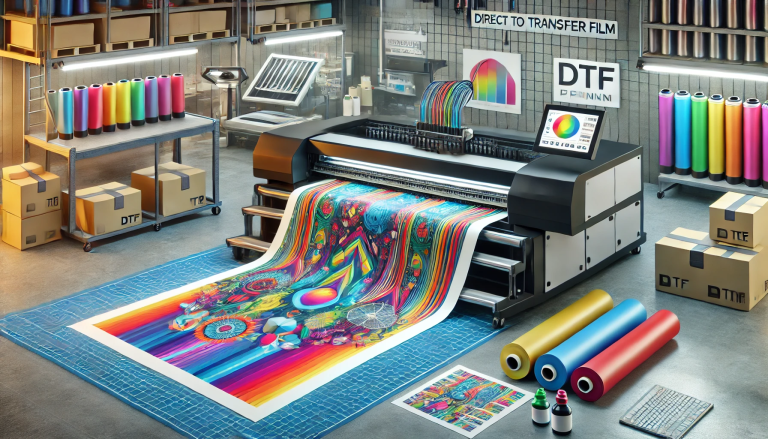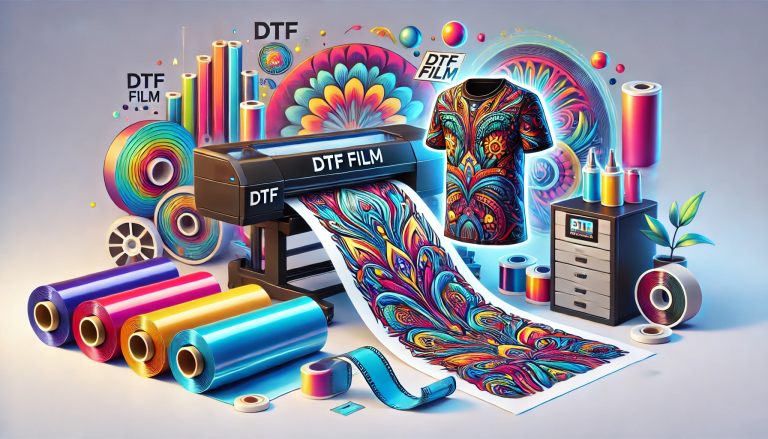“Unlock the Possibilities with DTF Transfer Film and Sublimation Ink!” -MAXDTF- PET Film para DTF Factory, DTF direct to Film Supplier, Made in China
Introduction
Sublimation ink is a popular choice for printing on fabrics and other materials. It is known for its vibrant colors and durability. But can you use sublimation ink on the DTF (Direct to Film) transfer film? The answer is yes, you can use sublimation ink on the DTF transfer film. This article will discuss the advantages and disadvantages of using sublimation ink on the DTF transfer film, as well as the best practices for achieving the best results.
Troubleshooting Common Issues When Using Sublimation Ink on DTF Transfer Film
Sublimation ink on DTF transfer film is a popular method for creating vibrant, full-color designs on a variety of materials. However, it can be difficult to get the desired results if you are not familiar with the process. Here are some tips for troubleshooting common issues when using sublimation ink on DTF transfer film.
- Poor Color Quality: Poor color quality is often caused by incorrect settings on the printer. Make sure that the printer is set to the correct resolution and color profile for the type of material you are printing on. Additionally, check that the printer is using the correct type of sublimation ink.
- Poor Image Quality: Poor image quality can be caused by several factors, including incorrect printer settings, incorrect paper type, or incorrect transfer film. Make sure that the printer is set to the correct resolution and color profile for the type of material you are printing on. Additionally, check that the paper type and transfer film is compatible with the printer and sublimation ink.
- Ink Bleeding: Ink bleeding can occur when the transfer film is not properly heated. Make sure that the transfer film is heated to the correct temperature for the type of material you are printing on. Additionally, check that the transfer film is properly aligned with the material before pressing.
- Poor Adhesion: Poor adhesion can be caused by incorrect settings on the heat press. Make sure that the heat press is set to the correct temperature and pressure for the type of material you are printing on. Additionally, check that the transfer film is properly aligned with the material before pressing.
By following these tips, you should be able to troubleshoot common issues when using sublimation ink on DTF transfer film. If you are still having difficulty, contact a professional for assistance.
Tips and Tricks for Getting the Best Results When Using Sublimation Ink on DTF Transfer Film
Sublimation ink is a great way to create vibrant, full-color designs on DTF transfer film. However, it is important to follow certain tips and tricks to ensure the best results. Here are some tips and tricks for getting the best results when using sublimation ink on DTF transfer film:
- Use the right type of sublimation ink. Make sure to use sublimation ink specifically designed for DTF transfer film. This type of ink is designed to bond with the film and create a vibrant, full-color design.
- Use the right type of printer. Make sure to use a printer that is specifically designed for sublimation printing. This type of printer is designed to handle the high temperatures required for sublimation printing.
- Use the right type of paper. Make sure to use a paper specifically designed for sublimation printing. This type of paper is designed to absorb the ink and create a vibrant, full-color design.
- Use the right temperature and pressure settings. Make sure to use the correct temperature and pressure settings for your printer and sublimation ink. This will ensure that the ink bonds properly with the film and creates a vibrant, full-color design.
- Use the right type of transfer film. Make sure to use a transfer film specifically designed for sublimation printing. This type of film is designed to bond with the ink and create a vibrant, full-color design.
- Use the right type of heat press. Make sure to use a heat press specifically designed for sublimation printing. This type of heat press is designed to apply the correct amount of heat and pressure to the transfer film and create a vibrant, full-color design.
By following these tips and tricks, you can ensure the best results when using sublimation ink on DTF transfer film. With the right tools and techniques, you can create vibrant, full-color designs that will last for years to come.
What You Need to Know Before Using Sublimation Ink on DTF Transfer Film
Before using sublimation ink on DTF (Direct to Film) transfer film, it is important to understand the process and the materials involved. Sublimation ink is a special type of ink that is designed to be used with a heat press. The ink is printed onto a special transfer film, which is then placed onto the garment or other substrate. The heat press is then used to transfer the ink from the film to the substrate.
When using sublimation ink on DTF transfer film, it is important to use the correct type of film. The film should be specifically designed for use with sublimation ink. It should also be compatible with the type of substrate that you are using. Additionally, the film should be compatible with the type of heat press that you are using.
It is also important to use the correct type of sublimation ink. The ink should be specifically designed for use with DTF transfer film. It should also be compatible with the type of substrate that you are using. Additionally, the ink should be compatible with the type of heat press that you are using.
When using sublimation ink on DTF transfer film, it is important to follow the manufacturer’s instructions for the heat press. The temperature and pressure settings should be adjusted according to the manufacturer’s instructions. Additionally, the time and number of passes should also be adjusted according to the manufacturer’s instructions.
Finally, it is important to use the correct type of substrate when using sublimation ink on DTF transfer film. The substrate should be specifically designed for use with sublimation ink. Additionally, the substrate should be compatible with the type of heat press that you are using.
By understanding the process and materials involved, you can ensure that you are using sublimation ink on DTF transfer film correctly. This will help to ensure that you get the best results from your project.
Exploring the Benefits of Using Sublimation Ink on DTF Transfer Film
Sublimation ink is a type of ink used in digital printing that is becoming increasingly popular for its ability to produce vibrant, long-lasting prints. Sublimation ink is used in combination with a special type of transfer film known as DTF (direct-to-film) transfer film. This type of film is designed to be used with sublimation ink and is capable of producing high-quality prints with excellent color accuracy and durability.
The use of sublimation ink on DTF transfer film offers several benefits over traditional printing methods. One of the most significant advantages is the ability to produce prints with a wide range of colors and shades. Sublimation ink is capable of producing a much wider range of colors than traditional inks, allowing for more vibrant and detailed prints. Additionally, the ink is highly resistant to fading and smudging, making it ideal for long-term use.
Another benefit of using sublimation ink on DTF transfer film is the ability to produce prints with a high level of detail. The ink is capable of producing prints with a resolution of up to 1440 dpi, which is significantly higher than traditional printing methods. This allows for prints with a high level of detail and clarity, making them ideal for applications such as signage and promotional materials.
Finally, the use of sublimation ink on DTF transfer film is also more cost effective than traditional printing methods. The ink is more affordable than traditional ink, and the cost of the film is significantly lower than other types of transfer film. This makes it an ideal choice for businesses looking to produce high-quality prints without breaking the bank.
Overall, the use of sublimation ink on DTF transfer film offers several benefits over traditional printing methods. The ink is capable of producing vibrant, long-lasting prints with a wide range of colors and shades, and it is also highly resistant to fading and smudging. Additionally, the ink is capable of producing prints with a high level of detail, and it is also more cost effective than traditional printing methods. For these reasons, sublimation ink on DTF transfer film is becoming increasingly popular for its ability to produce high-quality prints at an affordable price.
How to Achieve Professional Quality Prints with DTF Transfer Film and Sublimation Ink
Achieving professional quality prints with DTF transfer film and sublimation ink is a relatively simple process that can be done with the right equipment and materials. With the right combination of DTF transfer film and sublimation ink, you can create vibrant, long-lasting prints that will look great on any fabric. Here is a step-by-step guide to achieving professional quality prints with DTF transfer film and sublimation ink.
Step 1: Prepare Your Fabric
Before you begin printing, you must first prepare your fabric. Start by washing and drying the fabric to remove any dirt or debris. Once the fabric is clean, iron it to remove any wrinkles and ensure a smooth surface for printing.
Step 2: Prepare Your Printer
Once your fabric is ready, you must prepare your printer. Make sure your printer is compatible with DTF transfer film and sublimation ink. If not, you will need to purchase a compatible printer. Once your printer is ready, load the DTF transfer film into the printer.
Step 3: Print Your Design
Now it’s time to print your design. Use a graphics program to create your design and then print it onto the DTF transfer film. Make sure to use the correct settings for your printer and the DTF transfer film.
Step 4: Transfer Your Design
Once your design is printed onto the DTF transfer film, you must transfer it to your fabric. Place the DTF transfer film onto the fabric and use a heat press to transfer the design. Make sure to use the correct temperature and pressure settings for the fabric and the DTF transfer film.
Step 5: Apply Sublimation Ink
Once your design is transferred to the fabric, you must apply the sublimation ink. Use a sublimation printer to print the ink onto the fabric. Make sure to use the correct settings for your printer and the sublimation ink.
Step 6: Heat Set the Ink
Once the sublimation ink is printed onto the fabric, you must heat set it. Use a heat press to heat set the ink. Make sure to use the correct temperature and pressure settings for the fabric and the sublimation ink.
Step 7: Finish Your Print
Once the ink is heat set, your print is complete. Allow the fabric to cool before handling it. Your print should now be vibrant and long-lasting.
By following these steps, you can achieve professional quality prints with DTF transfer film and sublimation ink. With the right combination of materials and equipment, you can create vibrant, long-lasting prints that will look great on any fabric.
Conclusion
In conclusion, sublimation ink can be used on DTF transfer film, but it is important to ensure that the ink is compatible with the film and that the correct settings are used when printing. Additionally, it is important to use a heat press that is suitable for the type of material being printed on. With the right combination of ink, film, and heat press, sublimation ink can be used to create beautiful and long-lasting prints on DTF transfer film.






